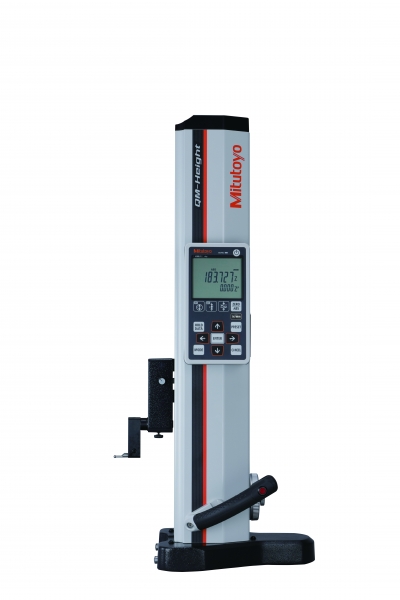
Mitutoyo America Corp. announces the release of the QM-Height series high-performance height gauge to its small tools line. The QM-Height is used to measure height, height difference (step), inside/outside widths, inside/outside diameters, circle pitch, free-form surface maximum/minimum heights and height difference by scanning measurement. It features an accuracy of ±(2.4+2.1L/600) μm, and a built-in pneumatic flotation system enables smooth movement over a surface plate.
Two subdisplay modes display the value from the previous measurements or the value from the zero/origin point. Origin points can also be set from hole centers. Highlighted features:
• GO/±NO GO judgment by LED and display symbols: LEDs indicate tolerance judgment status – green for GO, red for +NO GO, and orange for -NO GO. Additionally, status is indicated by corresponding symbols appearing on the display.
• Inside/outside diameters, maximum/minimum heights and displacement measured using a standard probe: Besides height measurement, Mitutoyo’s proprietary mechanism and firmware enables scanning measurement of inside/outside diameters, maximum/minimum heights, and height differences.
• ABSOLUTE encoder maintains the origin: The electromagnetic induction type ABSOLUTE encoder maintains the origin. The origin does not need to be set after turning on the power. (Except when there is a considerable environmental change).
• New d2 Digimatic and USB outputs: Digimatic and USB ports are standard. Using the U-WAVE-T measurement data wireless communication system enables instant transmission of measurement data to a PC via wireless communication reducing manual input errors and improves data reliability and operational efficiency.
• Increased Power Supply: 1,200 hours of battery life in continuous use.
• Air-suspension Feature: ressing a button on the grip activates the internal air pump. The base rises on a cushion of air and is able to be moved smoothly over the surface plate.
Contact Details
Related Glossary Terms
- centers
centers
Cone-shaped pins that support a workpiece by one or two ends during machining. The centers fit into holes drilled in the workpiece ends. Centers that turn with the workpiece are called “live” centers; those that do not are called “dead” centers.
- pitch
pitch
1. On a saw blade, the number of teeth per inch. 2. In threading, the number of threads per inch.
- tolerance
tolerance
Minimum and maximum amount a workpiece dimension is allowed to vary from a set standard and still be acceptable.
- turning
turning
Workpiece is held in a chuck, mounted on a face plate or secured between centers and rotated while a cutting tool, normally a single-point tool, is fed into it along its periphery or across its end or face. Takes the form of straight turning (cutting along the periphery of the workpiece); taper turning (creating a taper); step turning (turning different-size diameters on the same work); chamfering (beveling an edge or shoulder); facing (cutting on an end); turning threads (usually external but can be internal); roughing (high-volume metal removal); and finishing (final light cuts). Performed on lathes, turning centers, chucking machines, automatic screw machines and similar machines.






